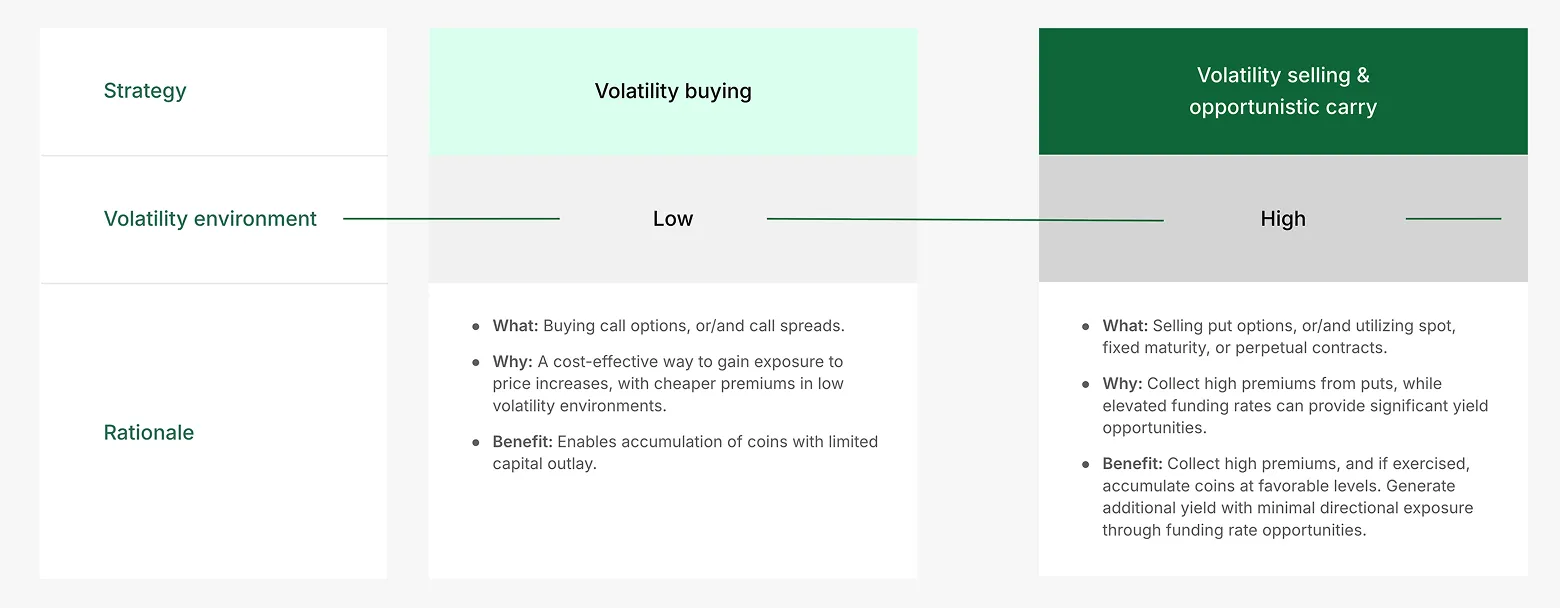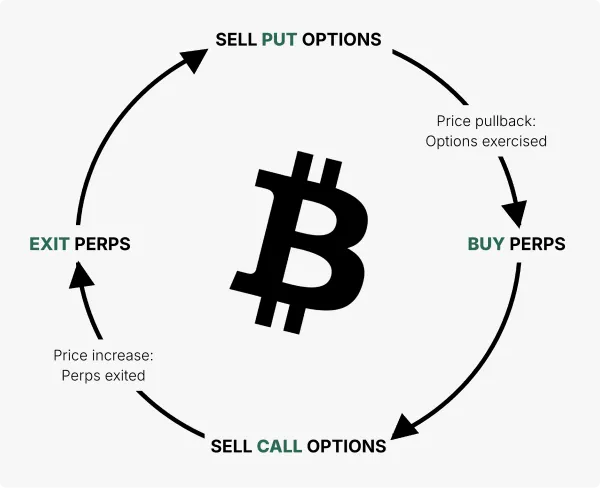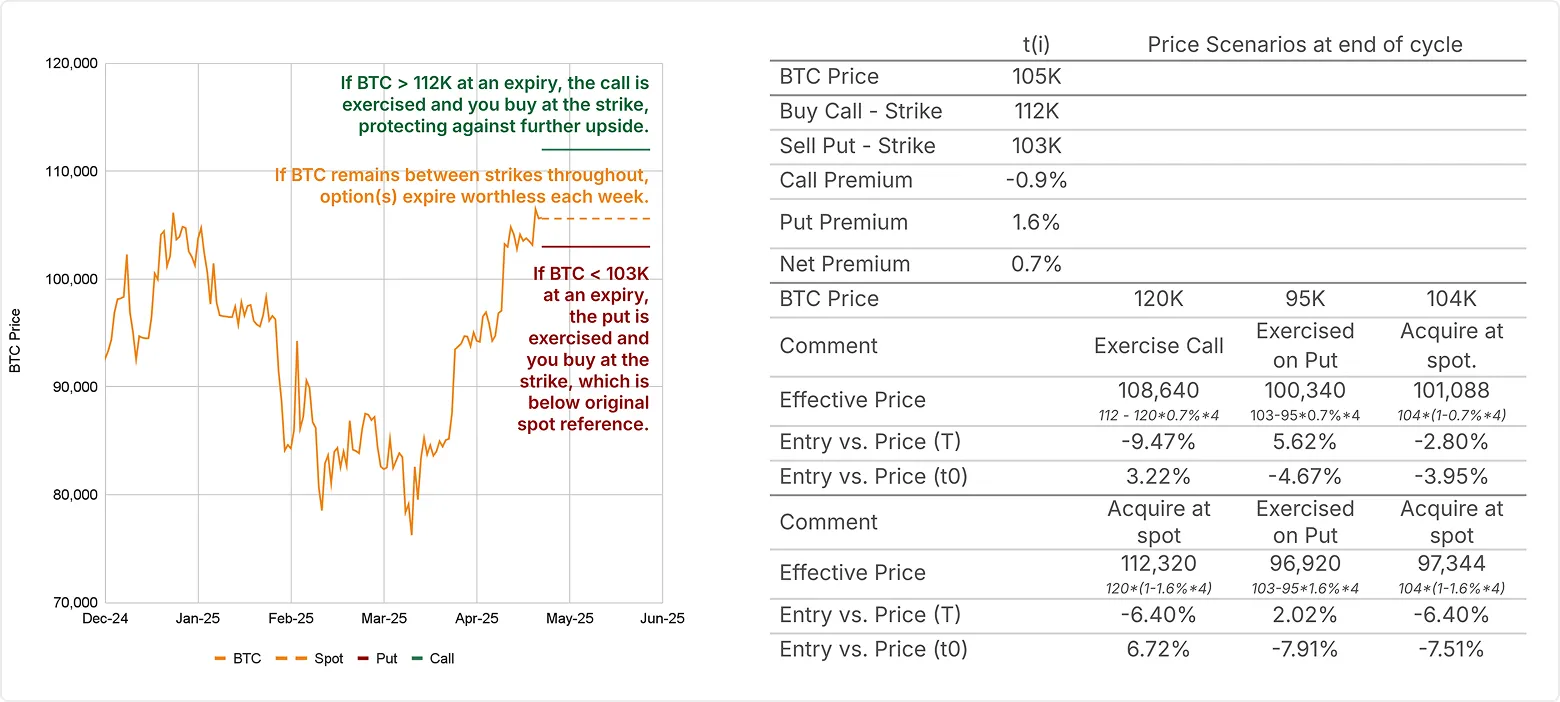

Crypto Options Trading: A New Way to Generate Yield (2025) | AI generated image by XBTO
Crypto Options Trading: A New Way to Generate Yield (2025) | AI generated image by XBTO
A growing number of institutional investors are turning to actively managed options strategies to harness volatility, optimize asset accumulation, and generate income across market conditions.
Alongside these strategies, annual percentage yield (APY) has become a key metric for comparing returns across different yield strategies, helping investors assess potential earnings.
Unlike traditional buy-and-hold strategies, crypto options trading provides flexibility, leverage, and risk management features that are particularly valuable in today’s dynamic digital asset environment.
This article explores how options can be used to enhance yield generation in crypto portfolios, with real-world examples, market-aligned strategies, and an institutional-grade risk framework.
The evolution of yield generation in crypto
Historically, yield generation in crypto primarily revolved around staking Proof-of-Stake (PoS) assets and providing liquidity to decentralized finance (DeFi) protocols. While these methods remain fundamental, some investors now seek stable yields through less volatile strategies that prioritize consistent, predictable returns.
The advent and refinement of crypto options offer a new dimension. In addition, new yield products have emerged that automate and optimize returns, allowing investors to benefit from advanced strategies without manual management.
Unlike traditional yield farming, which often exposes users to impermanent loss or significant market volatility, options allow for more nuanced risk management and the ability to profit from various market scenarios, including sideways or even slightly bearish movements.
In 2025, the demand for sophisticated yield generation strategies is at an all-time high. With Bitcoin cementing its position as a portfolio staple and Ethereum's layer-2 ecosystem expanding for mainstream use, the crypto market is attracting a broader range of participants, including institutional investors.
There is also a growing interest in crypto passive income as a mainstream investment goal, with more users seeking reliable ways to earn passive income through both CeFi and DeFi platforms. This influx of capital and growing sophistication necessitates more advanced tools like options to optimize returns and manage risk effectively.
What are crypto options, and how do they generate yield?
Crypto options are derivative contracts that give the holder the right, but not the obligation, to buy (call option) or sell (put option) a specific cryptocurrency at a predetermined price (strike price) on or before a certain date (expiration date). The seller of the option (the "writer") receives a premium from the buyer. This premium is the core mechanism for yield generation in crypto options trading.
Compared to other methods where investors can earn interest on their digital assets, such as staking, savings accounts, or crypto lending, options yield generation offers a unique risk-return profile and flexibility. This structure allows for highly customizable strategies:
- Selling options enables investors to earn premiums. Interest rate dynamics in lending platforms can influence how attractive options strategies are, as higher rates may shift investor preference between lending and options selling.
- Buying options offers leveraged exposure with limited downside.
- Structured combinations (e.g., spreads, straddles, strangles) can enhance yield or manage directional risk. Some advanced strategies involve using leverage to borrow funds, amplifying potential returns but also increasing risk.
The primary way to generate yield through crypto options is by selling them. When you sell an option, you collect the premium upfront. If the option expires worthless (i.e., the market price of the underlying asset doesn't move beyond the strike price in a way that makes it profitable for the buyer to exercise), you keep the entire premium as profit. This strategy allows investors to earn income by leveraging their existing crypto holdings or by taking a view on the market's future direction. Some protocols automate paying interest to depositors, similar to how options writers collect and distribute premiums.
Importantly, options are one of the few tools in crypto that allow investors to monetize volatility, transforming what is typically viewed as a risk into a source of alpha. An actively managed options investment strategy can be designed not only to generate yield but also to acquire coins at favorable levels. Automated options vaults and structured products have emerged, and some lending platforms and lending protocols now integrate options strategies for enhanced yield. Additionally, the rise of crypto lending offers a complementary way to earn interest and generate passive income alongside options-based approaches.
Both options and lending strategies allow investors to earn yield on their crypto holdings, providing multiple avenues for passive income and portfolio growth.
Popular strategies for yield generation with crypto options: Leveraging volatility
Several strategies leverage crypto options to generate yield, each with its own risk-reward profile, often dictated by the prevailing volatility environment.
- What: Selling put options, and/or utilizing spot, fixed maturity, or perpetual contracts.
- Why: This strategy is particularly effective in high volatility environments, as elevated volatility leads to higher option premiums. Selling put options allows for collecting significant upfront premiums. Additionally, high funding rates in perpetual contracts can provide substantial yield opportunities.
- Benefit: The primary benefit is collecting high premiums from puts. If the option is exercised (meaning the price drops below the strike price), the investor acquires the underlying cryptocurrency at a potentially favorable level (strike price minus the premium). This combines yield generation with asset accumulation at a discount.
- What: Selling call options against an existing holding of a cryptocurrency (e.g., Bitcoin or Ethereum).
- Why: This is a conservative strategy ideal for investors who are long-term bullish on their assets but expect limited short-term price appreciation. It allows them to earn income without selling their holdings.
- Benefit: If the asset's price remains below the strike price, the option expires worthless, and the investor keeps the premium as pure profit. If the price rises above the strike, the investor profits from the premium and the appreciation up to the strike price, while being prepared to sell the asset at the strike price.
- What: Selling put options while setting aside a corresponding amount of stablecoins to purchase the underlying asset if the option is exercised.
- Why: This strategy is designed for investors who are looking to acquire a specific cryptocurrency at a more favorable price. It provides a way to earn income while waiting for a potential price dip.
- Benefit: If the price stays above the strike price, the investor keeps the entire premium. If the price falls and the option is exercised, the investor is obligated to buy the crypto at the strike price, but the net cost is effectively reduced by the premium collected.
- What: Selling both a call and a put option on the same asset (straddle) or with different strike prices (strangle), often combined with a "carry" trade.
- Why: This advanced approach is optimized for range-bound markets with high volatility but minimal expected directional movement. It aims to profit from the time decay of the options. The "carry" component adds another layer of yield by exploiting funding rate differentials and cross-exchange arbitrage opportunities.
- Benefit: The goal is to maximize premium income from both the call and put options. As long as the asset's price stays within a profitable range, the premiums are collected, generating a market-neutral yield.
- What: Depositing cryptocurrency into a DeFi protocol or platform that automatically executes options strategies like covered calls or cash-secured puts.
- Why: These platforms simplify complex options trading, making it accessible to a wider audience without the need for manual execution or deep technical expertise.
- Benefit: Participants benefit from a hands-off approach to generating yield. The protocol handles the strategy, pooling funds to achieve greater efficiency and distributing the earned premiums to all depositors, lowering the barrier to entry for options-based income.
It is important to note that certain strategies require investors to actively manage their positions to optimize returns and control risk.
The investment process in practice: Accumulate Bitcoin through volatility
- Systematic put option selling: The fund systematically sells put options for a portion of its Net Asset Value (NAV). The goal here is to collect premiums. These options are designed to be exercised when a significant BTC price pullback occurs. Essentially, the fund is compensated for "buying the dip."
- Entering long BTC perpetual positions: When a market retracement causes a previously sold option to expire in the money, the strategy transitions into a long BTC perpetual position at the expiry price. This action increases the overall BTC exposure of the fund, aiming to benefit from a potential bounce or stabilization after the dip.
- Writing call options for excess exposure: The fund then actively seeks to sell this "excess exposure" (the newly acquired or increased BTC position) by systematically writing call options against it. This is a covered call strategy designed to further enhance the yield of the fund by collecting additional premiums.
- Closing long perpetual positions: When the market improves and BTC prices rise, the fund will close out its long perpetual futures positions to take profits.
- Reversion to put option selling: Upon the liquidation of the perpetual futures positions, the entire strategy reverts to its initial phase of systematic put option selling, restarting the cycle of yield generation and opportunistic asset accumulation.
This cyclical approach demonstrates a sophisticated interplay of options selling and perpetual futures trading to optimize yield across different market conditions.
Volatility is a feature of crypto. In Bitcoin, it’s structural, persistent, and can be harvested. Through volatility selling, the strategy enables:
- Repeatable yield generation by selling options in a richly priced market.
- Tactical coin accumulation at attractive levels during market pullbacks.
- Diversified return sources beyond mere price appreciation, reducing dependence on bull markets.
In short, volatility is an asset to be monetized.
Options-based BTC acquisition: Indicative example
A structured approach to BTC entry: Use weekly options to aim for better pricing. If none are exercised, we acquire BTC at spot after the strategy ends.
Tactical adaptation: Options by market conditions
Crypto markets are rarely static. Strategies must flex across bull, bear, and range-bound conditions. Options strategies can also be tailored to highly volatile assets, offering greater yield potential for those willing to manage increased risk:
Adaptation is key. Crypto investors must assess their risk tolerance and objectives when selecting and rotating strategies. Risk-adjusted returns are maximized by rotating strategies as volatility regimes and trend signals change. These approaches can help generate passive income for investors across different market cycles.
Risks and rewards associated with yield generation through crypto options
While yield generation through crypto options presents compelling opportunities, it is crucial to understand the inherent risks:
- Passive income: Options premiums offer a consistent income stream, regardless of significant price appreciation.
- Capital efficiency: Can generate yield on existing crypto holdings without selling them.
- Diversification of income sources: Adds a new dimension to a crypto portfolio's yield strategies.
- Hedging capabilities: Options can also be used to hedge against downside risk in a portfolio, although this typically involves buying options rather than selling for yield.
- Asset accumulation at favorable prices: As emphasized in the strategies, selling puts can lead to acquiring assets at a discount when exercised.
- Market volatility: While options can profit from sideways markets, extreme volatility can lead to significant losses, especially for uncovered (naked) option selling.
- Liquidation risk (for leveraged positions): If selling options on margin or utilizing perpetual contracts, a sudden adverse price movement can lead to liquidation.
- Assignment risk: The seller of an option can be "assigned," meaning they are obligated to buy or sell the underlying asset at the strike price. This can result in selling appreciated assets at a lower price (covered calls) or buying depreciated assets at a higher price (cash-secured puts).
- Smart contract vulnerabilities (for DEXs): Bugs or exploits in the smart contracts governing decentralized options platforms can lead to loss of funds.
- Time decay: While beneficial for options sellers, it also means that the value of the option erodes over time, requiring active management.
- Counterparty risk (for CEXs): The risk that the exchange itself may face solvency issues or be hacked.
- Regulatory uncertainty: While improving, the regulatory landscape for crypto derivatives, including options, is still evolving and can pose risks of unexpected changes.
Robust risk management is paramount. This includes monitoring with qualitative and quantitative predefined rules/limits such as stop losses (e.g., 5% to 10% on "accumulated delta" exposure) and well-defined Value at Risk (VaR) limits. A strong Governance framework provides independent oversight, defining portfolio reviews, collateral management, and risk limits approved by the board of directors.
Regulatory considerations
As the crypto industry matures, the regulatory landscape surrounding yield generation and DeFi platforms is becoming increasingly complex. Regulatory bodies worldwide are paying closer attention to how yield is generated from crypto assets, particularly as these strategies grow in popularity among both retail and institutional investors. Navigating this evolving environment requires investors to stay informed about the latest legal requirements and compliance obligations that may impact their investment strategies.
Uncertainty around regulations can introduce additional risks, including potential changes to how DeFi platforms operate or how yield income is taxed. Investors must also consider the tax implications of earning yield from crypto assets, as reporting requirements and tax treatments can vary significantly by jurisdiction. By understanding the regulatory landscape and proactively managing compliance and tax considerations, investors can better protect their interests and make informed decisions when participating in yield generation opportunities within the crypto ecosystem.
The future of crypto options as a yield-generating instrument
The long-term outlook for crypto options as a yield-generating instrument is exceptionally promising. Several factors contribute to this positive trajectory:
- Maturing market infrastructure: The underlying technology and infrastructure for crypto options are continuously improving, with more robust platforms, better pricing models, and enhanced liquidity.
- Institutional adoption: As regulatory clarity increases and traditional financial institutions become more comfortable with crypto, they are increasingly looking to derivatives like options for risk management and yield enhancement. This institutional flow brings significant capital and sophistication to the market.
- Technological advancements: Innovations in blockchain technology, particularly in layer-2 scaling solutions, are making options trading faster, cheaper, and more efficient. Furthermore, advancements in decentralized finance (DeFi) are leading to more sophisticated and user-friendly automated options strategies and structured products. Tokenization, the process of representing real-world assets on the blockchain, is also set to expand dramatically in 2025, potentially creating new underlying assets for options contracts and further diversifying yield opportunities.
- Increased education and accessibility: As the crypto market matures, there's a greater emphasis on investor education. Platforms are simplifying the complexities of options, making them more accessible to a broader retail audience through user-friendly interfaces and educational resources.
- Macroeconomic influences: In a global macroeconomic climate characterized by varying interest rates and inflation concerns, investors are actively seeking alternative sources of yield. Crypto options offer a compelling alternative to traditional fixed-income instruments, particularly in periods of low interest rates or market uncertainty.
Yield generation in crypto has evolved
Options trading is no longer the domain of speculators - it’s a cornerstone of modern yield strategies for digital asset portfolios. Whether you’re looking to accumulate coins, hedge risk, or extract income from volatility, options offer an essential toolkit.
Actively managed strategies that dynamically adapt across volatility environments, incorporate perpetual instruments, and follow disciplined risk controls can deliver yield while positioning for long-term asset appreciation.
The full breakdown
In our first article, "Navigating Crypto Volatility: The Advantages of Active Management," we explored how the high volatility and low correlation of digital assets with traditional asset classes create unique opportunities for active managers. We discussed how these characteristics enable active managers to execute tactical trading strategies, capitalizing on short-term price movements and market inefficiencies. Building on that foundation, we now turn our attention to the unique market microstructure of digital assets.
Conducive market microstructure of digital assets
The market microstructure of digital assets - a framework that defines how crypto trades are conducted, including order execution, price formation, and market interactions - sets the stage for active management to thrive. This unique ecosystem, characterized by its continuous trading hours, diverse trading venues, and substantial market liquidity, offers several advantages for active management, providing a fertile ground for sophisticated investment strategies.
24/7/365 market access
One of the defining characteristics of digital asset markets is their continuous, round-the-clock operation.
Unlike traditional financial markets that operate within specific hours, cryptocurrency markets are open 24 hours a day, seven days a week, all year round. This continuous trading capability is particularly advantageous for active managers for several reasons:
- Immediate response to market events: Unlike traditional markets that close after regular trading hours, digital asset markets allow managers to react immediately to breaking news or events that could impact asset prices. For instance, if a significant economic policy change occurs over the weekend, managers can adjust their positions in real-time without waiting for markets to open.
- Managing volatility: Continuous trading provides more opportunities to capitalize on price movements and volatility. Active managers can take advantage of this by implementing strategies such as short-term trading or hedging to mitigate risks and lock in gains whenever market conditions change. For instance, if there’s a sudden drop in the price of Bitcoin, managers can quickly sell their holdings to minimize losses or buy in to capitalize on the lower prices.
Variety of trading venues
The proliferation and variety of trading venues is another crucial element of the digital asset market structure. The extensive landscape of over 200 centralized exchanges (CEX) and more than 500 decentralized exchanges (DEX) offers a wide array of platforms for cryptocurrency trading. This diversity is beneficial for active managers in several ways:
- Risk management and diversification: By spreading trades across various exchanges, active managers can mitigate counterparty risk associated with any single platform. Additionally, the ability to trade on both CEX and DEX platforms allows managers to diversify their strategies, incorporating different levels of decentralization, regulatory environments, and security features.
- Arbitrage opportunities: Different venues often exhibit price discrepancies, presenting arbitrage opportunities. For example, managers can buy an asset on one exchange at a lower price and sell it on another where the price is higher, thus generating risk-free profits.
- Access to diverse liquidity pools: Multiple trading venues provide access to diverse liquidity pools, ensuring that managers can execute large trades without significantly impacting the market price.
Spot and derivatives markets (Variety of instruments)
The seamless integration of spot and derivatives markets within the digital asset space presents a considerable advantage for active managers. With substantial liquidity in both markets, they can implement sophisticated trading strategies and manage risk more effectively.
For instance, as of August 8 2024, Bitcoin (BTC) boasts a daily spot trading volume of $40.44 billion and an open interest in futures of $27.75 billion. Additionally, derivatives such as futures, options, and perpetual contracts enable managers to hedge positions, leverage trades, and employ complex strategies that can amplify returns.

Overall, the benefits for active managers include:
- Hedging and risk management: Derivatives offer a powerful tool for hedging against unfavorable price movements, enabling more efficient risk management. For instance, a manager holding a substantial amount of Bitcoin in the spot market can use Bitcoin futures contracts to safeguard against potential price drops, thereby enhancing risk control.
- Access to leverage: Managers can use derivatives to leverage their positions, amplifying potential returns while maintaining control over risk exposure. For instance, by employing options, a manager can gain exposure to an underlying asset with only a fraction of the capital needed for a direct spot purchase, thereby enabling more capital-efficient investment strategies.
- Strategic flexibility: By integrating spot and derivatives markets, managers can implement sophisticated strategies designed to capitalize on diverse market conditions. For instance, they may engage in volatility selling, where options are sold to generate income from market volatility, regardless of price direction. Additionally, managers can leverage favorable funding rates in perpetual futures markets to enhance yield generation. Basis trading, another strategy, involves taking offsetting positions in spot and futures markets to profit from price differentials, enabling returns that are independent of market movements.
Exploiting market inefficiencies
Digital asset markets, being relatively nascent, are less efficient compared to traditional financial markets. These inefficiencies arise from various factors, including regulatory differences, market segmentation, and varying levels of market maturity. For example:
- Pricing anomalies: Phenomena like the "Kimchi premium," where cryptocurrency prices in South Korea trade at a premium compared to other markets, create arbitrage opportunities. Managers can exploit these by buying assets in one market and selling them in another at a higher price.
- Exploiting mispricings: Active managers can identify and capitalize on mispricings caused by market inefficiencies, using strategies such as statistical arbitrage and mean reversion.
The unique aspects of the digital asset market structure create an exceptionally conducive environment for active management. Continuous trading hours and diverse venues provide the flexibility to react quickly to market changes, ensuring timely execution of trades. The availability of both spot and derivatives markets supports a wide range of sophisticated trading strategies, from hedging to leveraging positions. Market inefficiencies and pricing anomalies offer numerous opportunities for generating alpha, making active management particularly effective in the digital asset space. Furthermore, the ability to hedge and manage risk through derivatives, along with exploiting uncorrelated performance, enhances portfolio resilience and stability.
In our next article, we'll delve into the various techniques active managers employ in the digital asset markets, showcasing real-world use cases.
Read full disclaimer
















